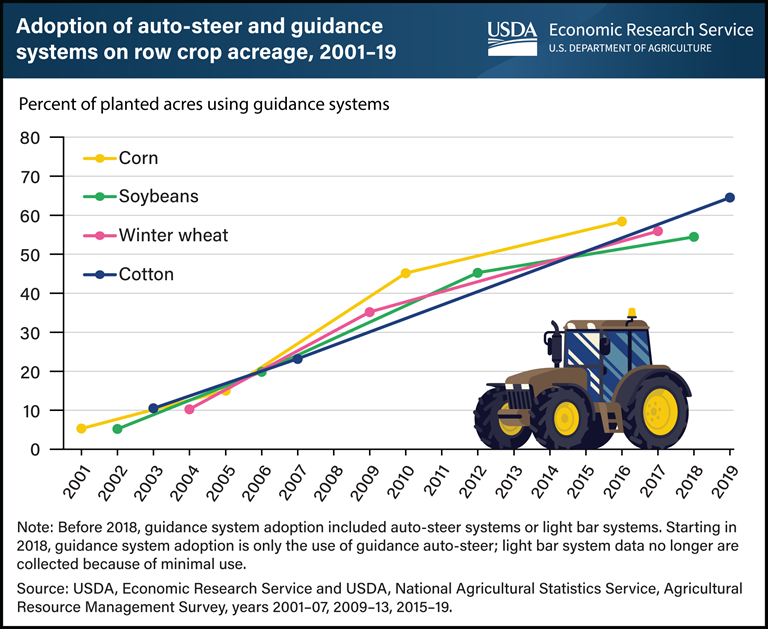Farmers embrace technology to advance sustainability
Author
Published
4/21/2023
I remember one of the first times my dad sent me out to disk cornstalks to help get our fields ready for planting. After a few rounds, I realized that I wasn’t driving as straight as I thought because when I looked behind the tractor I noticed a gap of stalks that hadn’t been touched by the disk.
I quickly went back to correct that error before my dad could notice and for the rest of the afternoon, I made sure that I had plenty of overlap so there weren’t any more noticeable mistakes. I’m not sure how much extra fuel was consumed by that strategy but at least the field was ready to plant when I was done.
I was reminded of that memory when I saw a chart from the USDA reporting that most row crop acreage is now managed using auto-steer and guidance systems, which use signals beamed down from satellites to keep tractors on a straight line with sub-inch accuracy. Guidance systems were used on 58.4% of corn acres in 2016 and 54.5% of soybean acres in 2018, the most recent years for which data are available, and have only continued to climb since then.

As we celebrate Earth Day, it’s a good time to recognize the many ways that farmers are embracing innovations in agricultural technology to make farming more efficient and sustainable while addressing global challenges like climate change and food security.
While the rest of the world fawns over self-driving Teslas, farmers have been pioneering similar technology for more than two decades to grow more food while using fewer resources.
Few technologies have been adopted as swiftly as auto-steer guidance systems. In 2002, only around 5% of corn and soybean acres were managed using those technologies. Today, engineers have developed fully autonomous tractors that don’t require an operator on board, although at this point farmers are still in the tractor cab even if they’re letting the machine do the steering.
Not only does auto-steer help farmers get the “picket fence” stands they’re looking for to achieve optimal crop yields, but it also reduces input costs such as fuel, fertilizer and herbicides by avoiding row overlap. The technology also enhances farm safety by reducing stress and fatigue for machine operators.
There’s a vast array of other precision agriculture innovations that are making farming more sustainable by optimizing resource use, soil health, pest control and weed management. For example, John Deere and other manufacturers have introduced innovative spraying systems that use computer vision and machine learning to target weeds in crop fields. The system turns individual nozzles off and on to spray only when the cameras detect weeds, which can reduce herbicide use by more than two-thirds.
Cloud-based computing is also changing agriculture by providing farmers with data-driven insights, enabling them to make more informed decisions and optimize farming practices. Future advancements in farming technology will include the increased use of artificial intelligence, robotics and drones for monitoring and managing crops and livestock.
So, when you see farmers out planting their fields this spring, know that they are leading the way in innovation that makes growing and raising food more efficient and more environmentally stable than ever.
Want more news on this topic? Farm Bureau members may subscribe for a free email news service, featuring the farm and rural topics that interest them most!